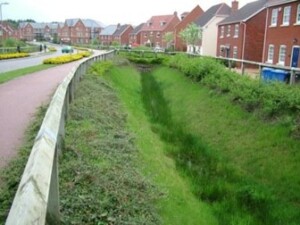Project highlights
- Habitat enhancement for biodiversity
- Developing multi-functional urban green spaces to provide nature-based solutions
- Translating science into planning policy and practice to help create more sustainable urban environments.
Overview
As human society becomes increasingly urbanised, green space in urban centres has grown in importance. It can provide a range of benefits, such as flood-risk mitigation and nutrient management whilst contributing to the health and well-being of residents. Urban greenspace can also provide habitats that support biodiversity and bring people closer to nature.
However, little is known about creating and maintaining species-rich habitats within urban settings, which are often laden with plant nutrients. This project would aim to use current ecological theory on the drivers of diversity in plant communities to understand how species-rich grasslands can be established and maintained in an urban environment. Focusing on a range of urban grassland systems, niche-partitioning theory would be used to look at the drivers of current plant diversity. We would then work with local partners to carry out experimental changes to explore whether diversity could be increased.
Milton Keynes is a rapidly expanding city with a commitment to sustainability and improving urban biodiversity. It would be used as a model city to give the work a geographic focus and we would seek to work with partners to investigate the local policy-making process and how it might support greater urban biodiversity. By strengthening the link between planning policy and practice for green space and leading-edge biodiversity science, the proposal holds significant potential to increase the effectiveness of planning policy to create more sustainable urban environments.
Figure 1: A sustainable urban drainage (SUD) scheme as part of a new housing development in Cambridge. Creative Commons: https://www.weadapt.org/sites/weadapt.org/files/legacy-new/placemarks/images/original/4eb532aa904c4suds-housing.jpeg
Host
The Open UniversityTheme
- Climate and Environmental Sustainability
- Organisms and Ecosystems
Supervisors
Project investigator
David Gowing (OU, [email protected])
Co-investigators
Phil Wheeler (OU, [email protected])
Matthew Cook (OU [email protected])
How to apply
- Each host has a slightly different application process.
Find out how to apply for this studentship. - All applications must include the CENTA application form. Choose your application route
Methodology
The precise scope of the work would be developed with local partners (MK parks Trust, MK City Council, MK Natural History Society) but it would focus on public open space, such as the various SUD schemes around the city. Sampled plots would be analysed in terms of their soil-water regime and their nutrient availability. A smaller subset of plots would be manipulated in terms of these environmental variables to monitor the response of the plant community.
The results of the survey work would be used to develop strategies for increasing the biodiversity and ecosystem services provided by these areas. The student would work alongside planners and associated policy makers in local authorities to identify how and where policy development is required. The student would also work with planning organisations such as the Town and Country Planning Association to promulgate the findings of the work at the national scale.
Training and skills
Students will be awarded CENTA2 Training Credits (CTCs) for participation in CENTA2-provided and ‘free choice’ external training. One CTC equates to 1⁄2 day session and students must accrue 100 CTCs across the three years of their PhD.
The successful student would be trained in the following skills:
- Sampling techniques in the field
- Plant identification
- Soil structural analysis
- Measurement of soil-nutrient status
- GIS mapping
- Statistical analysis techniques (including programming in R)
- Qualitative data collection (e.g. interviews and participant observation) and analysis, e.g. thematic analysis
- Ecosystem-services and associated planning policy and practice
Partners and collaboration
Both the Parks Trust and the City Council in Milton Keynes have expressed interest in the research project and are happy to collaborate.
Further details
Further details on how to contact the supervisor for this project and how to apply for this project can be found here:
For any enquiries related to this project please contact David Gowing, [email protected].
To apply to this project:
- You must include a CENTA studentship application form, downloadable from: CENTA Studentship Application Form 2024.
- You must include a CV with the names of at least two referees (preferably three) who can comment on your academic abilities.
- Your application materials, including the CENTA application form 2024, your CV and the Open University application form must be emailed to [email protected]. Instructions on how to apply to the Open University are to be found on https://www5.open.ac.uk/stem/environment-earth-ecosystem-sciences/research/phd-students/current-opportunities-and-how-apply, please ensure you read this webpage before applying as you will need to obtain the relevant OU application form from here. Please quote CENTA 2024-OU6 when completing the application form.
Applications must be submitted by 23:59 GMT on Wednesday 10th January 2024.
Possible timeline
Year 1
Literature review. Skills development (particularly plant identification and field sampling techniques, statistical analysis and coding). Selection of sites for experimental manipulation. Baseline surveys of these.
Year 2
Maintenance of experimental sites. Observational surveys across a wider range of urban green space. Liaison and data collection with groups engaged in policy development.
Year 3
Data analysis. Planning a thesis structure and start of drafting.
Further reading
Silvertown, J., Araya, Y. N. & Gowing, D. J. (2015) Hydrological niches in terrestrial plant communities: a review. Journal of Ecology, 103, 93–108
Bowskill, V., Bhagwat, S., Gowing, D. (2023) Depleting soil nutrients through haymaking on floodplain meadows for habitat restoration and nutrient neutrality. Biological Conservation Wildman, S. (2009) ‘Nursing and the issue of ‘party’ in the Church of England: the case of the Lichfield Diocesan Nursing Association’, Nursing Inquiry, 16, pp. 94–102. doi: 10.1111/j.1440‐1800.2009.00441.x.
Abenyenga, O., Burgess, P., Cook, M., Morris, J. (2009) Application of an ecosystem function framework to perceptions of community woodlands, Land Use Policy 26(3) 551-557.

